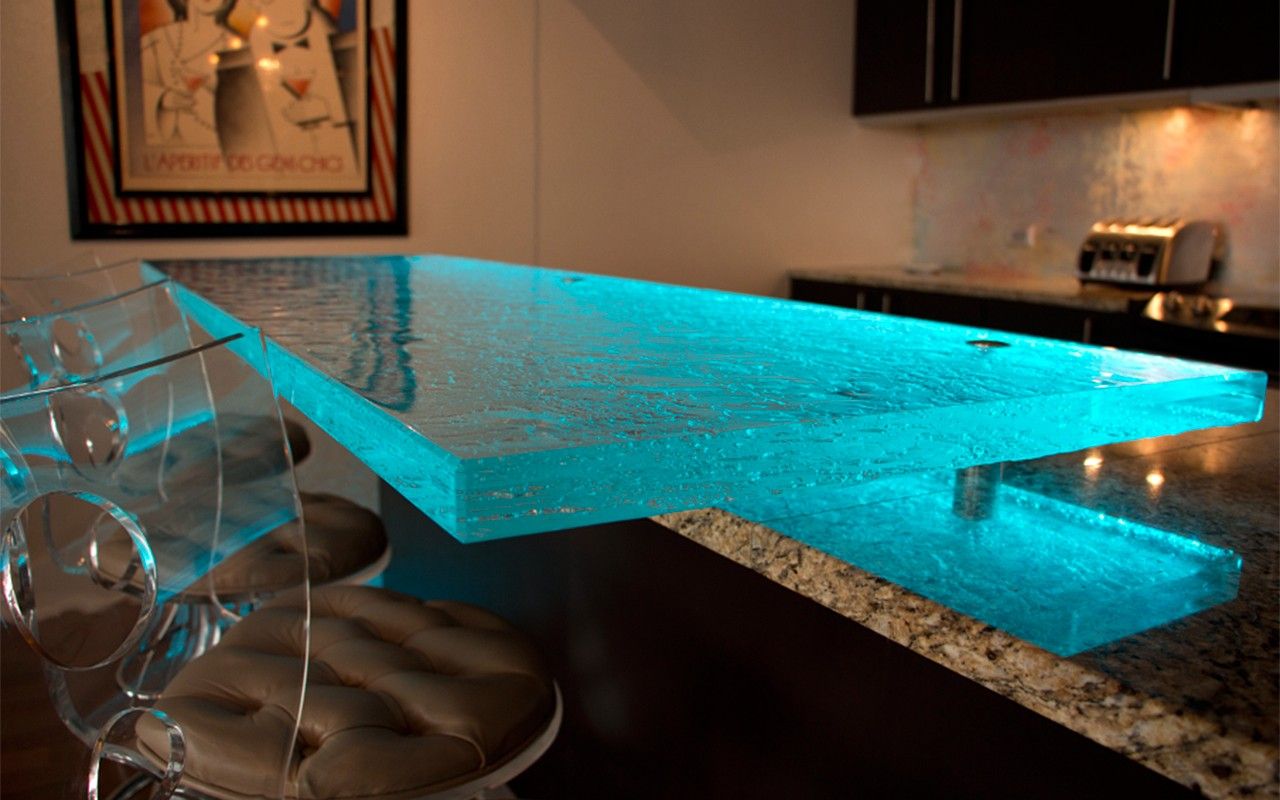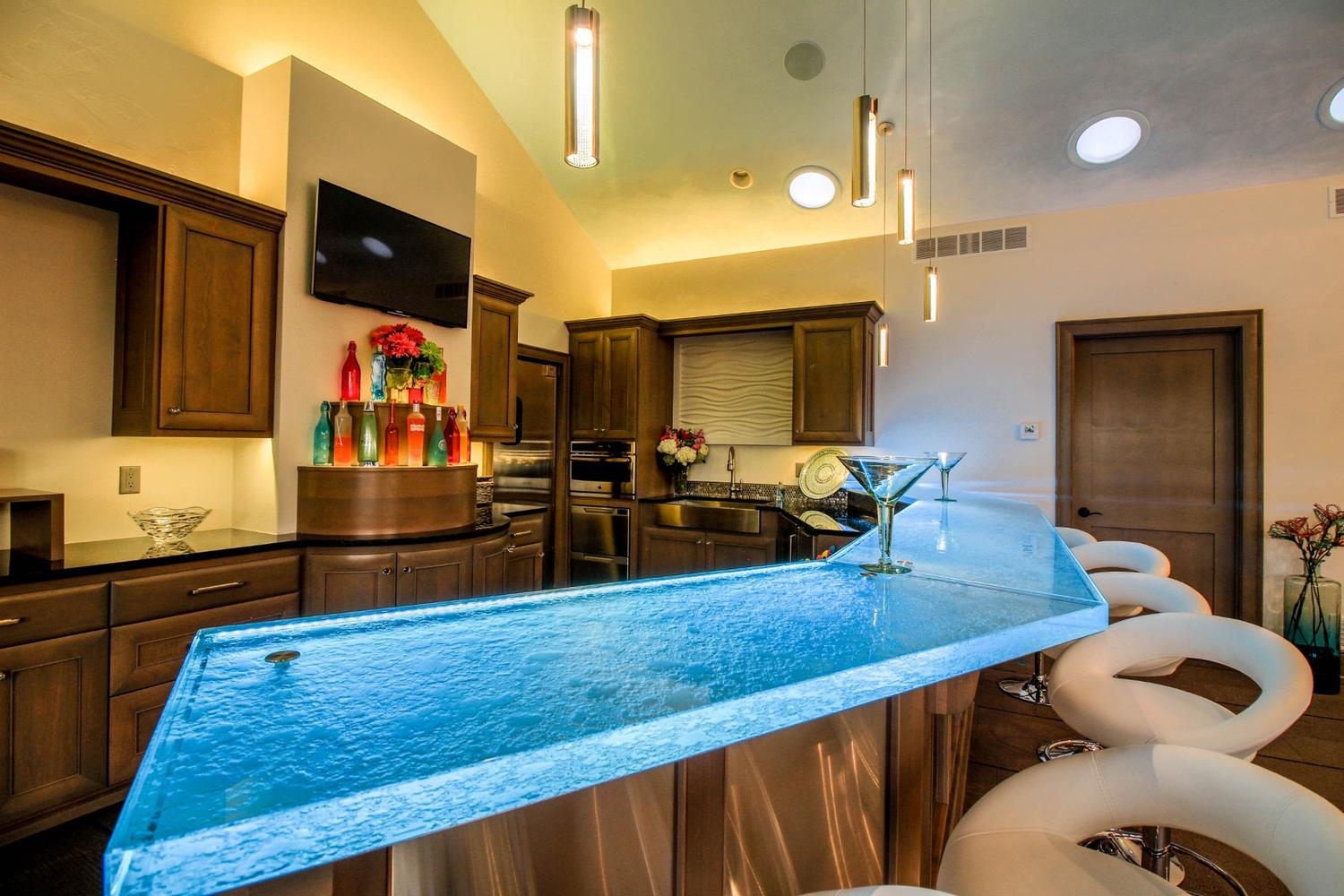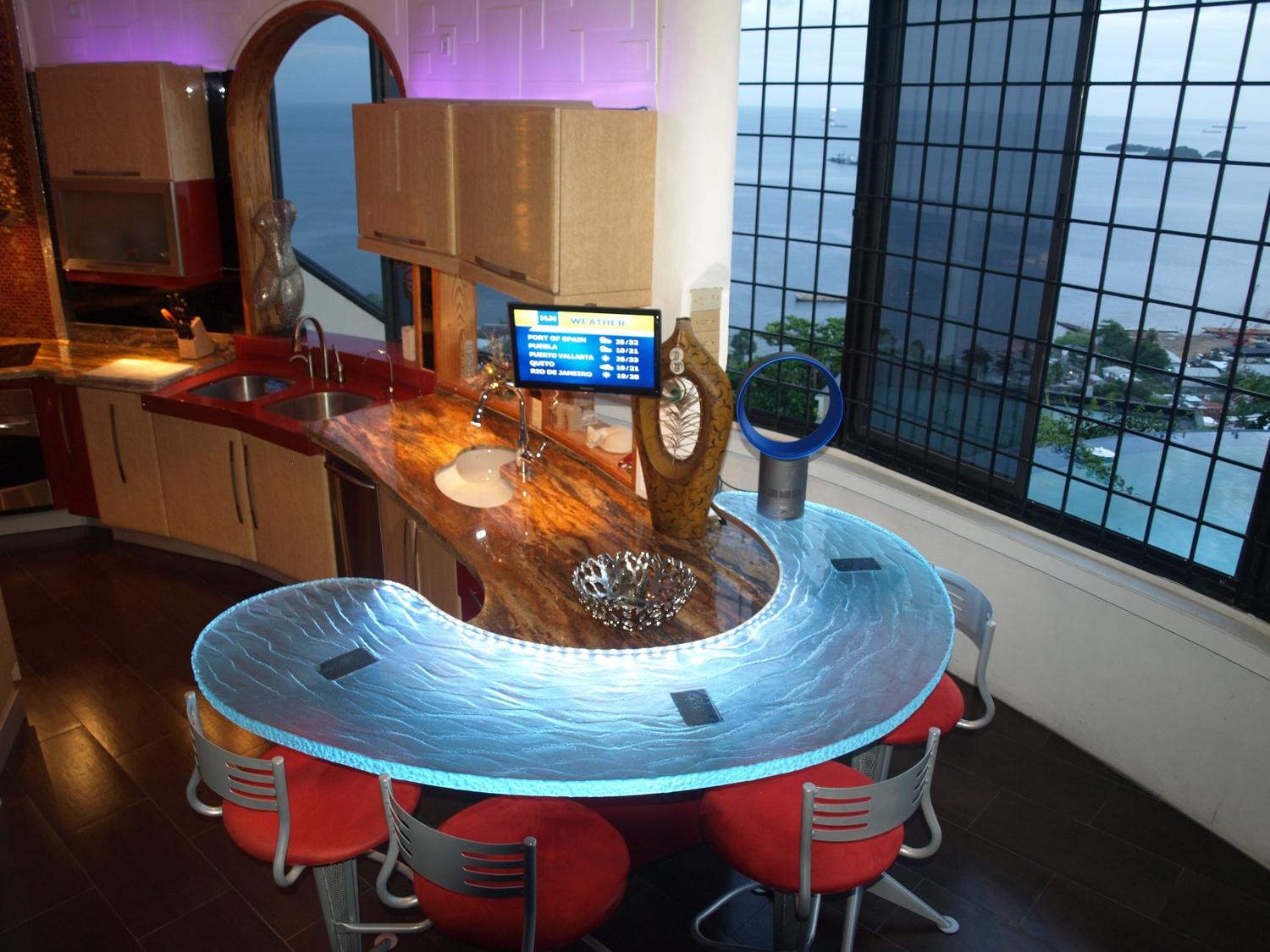Glass has always been a symbol of sophistication in social environments. From historic taverns to modern cocktail lounges, glass defines the drinking experience, not only in the glassware used for serving but also in the very surfaces that host the social ritual of drinking. In North America, the rise of glass bar countertops represents a major shift in design and material choice, blending durability, hygiene, and dramatic aesthetics. At the same time, glassware maintenance has become a critical operational element in ensuring quality service, safety, and customer satisfaction.
This guide provides an authoritative overview of glass in bar environments, both as a material for countertops and as the essential medium for serving drinks. It combines insights from material science, hospitality industry standards, and practical maintenance know-how to deliver a resource relevant to bar owners, interior designers, and homeowners in 2025.

The Rise of Glass in Modern Bar Design
Glass has moved beyond being just a practical necessity. In recent years, it has become a centerpiece in the design of bars, both residential and commercial. Glass countertops offer a striking departure from traditional wood, stone, or laminate, introducing light, color, and ambiance in a way no other surface can. Industry data shows that luxury hospitality projects in the U.S. and Canada increasingly specify glass bar tops, particularly when integrated with LED lighting for dynamic nighttime atmospheres.
Several factors explain this trend:
- The aesthetic flexibility of glass, which can be clear, frosted, textured, tinted, or cast with artistic patterns.
- Its non-porous nature, making it far superior to porous materials like wood or natural stone in terms of sanitation.
- The growing popularity of eco-friendly construction materials, with recycled glass countertops contributing to circular economy goals.
Bars are spaces of high turnover, heavy use, and constant exposure to liquids. Glass provides a balance between visual drama and functional practicality unmatched by most other countertop options.
Why Choose Glass for Bar Countertops?
Aesthetic Benefits
Glass has a natural affinity with light. In a bar environment, where mood and ambiance matter as much as service, glass transforms spaces:
- Transparency and Reflection: Enhances lighting design, reflects interior décor, and visually expands tight spaces.
- Integration with LEDs: Thick cast glass can house embedded LED channels, allowing bars to shift from a warm glow at happy hour to vibrant colors during late-night service.
- Artistic Texture: Artisanal cast or fused glass can mimic water ripples, ice formations, or abstract patterns, making every countertop a design statement.
Practical Advantages
- Non-Porous Hygiene: Unlike stone or wood, glass does not absorb liquids, oils, or bacteria, making it ideal for spills common in bars.
- Durability Against Traffic: Modern tempered and laminated glass withstand the constant impact of bottles, glasses, and bar tools.
- Heat Resistance: A key advantage in professional environments where warm glasses or plates may contact the surface.
- Sustainability: Many fabricators use recycled glass or reprocess cullet, supporting eco-conscious businesses.
Market Context
Surveys in 2024 showed that over 20% of luxury hospitality renovations in North America specified glass bar tops, up from just 8% a decade ago. In residential settings, glass bar counters have become a premium feature in high-end homes, particularly in entertainment spaces and outdoor kitchens.

Material Science of Glass Countertops in Bars
Cast/Fused Glass
- Manufacture: Molten glass poured into molds, cooled slowly for structural stability.
- Design: Thickness up to 4”, often textured or sculptural, with integrated lighting options.
- Durability: Extremely resistant to chips, scratches, and UV degradation.
- Use Case: Premium bars, luxury residential counters, design-driven projects.
Tempered Glass
- Process: Heated to ~1200°F and rapidly cooled, giving surface compression up to 4–5x stronger than annealed glass.
- Strength: Withstands daily bar traffic and moderate impacts.
- Safety: Shatters into small, blunt fragments, reducing injury risk.
- Use Case: Affordable, modern bar settings; widely available and versatile.
Laminated Glass
- Composition: Two or more layers of glass bonded with an interlayer (PVB/EVA).
- Safety: Holds together if broken; critical for high-traffic commercial environments.
- Thickness: Typically 3/4" to 1.5".
- Use Case: Hotels, nightclubs, and public bars where safety codes require laminated installations.
Recycled Glass Composites
- Composition: Shards of recycled glass set in resin or cement.
- Visual: Mosaic-like appearance.
- Sustainability: Appeals to eco-conscious consumers.
- Limitations: Less luminous than solid glass slabs.
.jpg)
Durability: Facts and Realities
One of the biggest misconceptions is that glass is fragile. In reality, modern engineered glass rivals stone and metal in toughness.
- Load-Bearing Capacity: Properly installed glass bar countertops meet or exceed load requirements for commercial use.
- Scratch Resistance: Tempered glass resists minor abrasions, though coasters and mats are recommended for longevity.
- Impact Resistance: Laminated and cast glass minimize risks of catastrophic failure.
- Thermal Performance: Withstands sudden temperature changes, though trivets are recommended for direct hot pans.
Comparative durability (scale 1–10):
- Tempered Glass: 7
- Laminated Glass: 7.5
- Cast/Fused Glass: 9
- Granite: 9
- Stainless Steel: 8
- Solid Wood: 7
Maintenance of Glass Bar Countertops
A bar’s reputation often rests on cleanliness and presentation. Glass makes this easier, but requires disciplined care.
Daily Maintenance
- Wipe with microfiber cloths and non-abrasive glass cleaner.
- Remove acidic spills (wine, citrus, vinegar) promptly to avoid staining supports or frames.
- Buff with lint-free cloths for a streak-free shine.
Weekly/Monthly Maintenance
- Inspect edges and joints for chips.
- Deep-clean textured surfaces with specialized brushes.
- Maintain LED channels (if integrated) to avoid dust accumulation.
What to Avoid
- Abrasive sponges or powders.
- Harsh alkali cleaners that may dull finish.
- Placing excessively heavy objects without support.
Practical advice:
- For modest budgets and minimalist kitchens, tempered glass works well.
- For families and public-facing spaces, laminated adds safety.
Glassware: Maintenance Best Practices in Bars
If countertops are the stage, glassware is the actor. Proper care ensures both aesthetics and hygiene.
Washing
- Dedicated Glass Washers: Operate at 130–160°F for thorough cleaning without thermal shock.
- Detergents & Rinse Aids: Use bar-specific formulas to prevent spotting and haze.
- Polishing: Air-dry or polish with microfiber; avoid cotton which leaves lint.
Handling
- Train staff to avoid stacking glasses.
- Use racks for transport and drying.
- Inspect for chips and cracks daily, damaged glass should be removed immediately.
Storage
- Store stemware upright to prevent rim damage.
- Use protective racks to prevent scratching.
- Keep away from high-traffic walkways to avoid accidents.
Residential vs Commercial Bar Use
Residential
- Typically lower traffic but still benefits from glass’s elegance and hygiene.
- Cast glass often chosen for design impact in entertainment rooms.
- Maintenance is straightforward: weekly cleaning suffic

Commercial
- Requires stricter adherence to safety codes (laminated/tempered).
- Glassware turnover is high, requiring industrial washers and daily inspections.
- Aesthetic role is heightened, bars compete for customer attention.

North American Trends in 2025
- LED Integration: Bars increasingly use programmable lighting under glass tops.
- Eco-Conscious Materials: Rise in recycled glass composites for sustainability branding.
- Outdoor Applications: Glass specified for poolside or rooftop bars with UV-stable finishes.
- Artisanal Cast Glass: Unique textures mimicking natural phenomena dominate luxury projects.
- Hygiene as Design: Post-pandemic, cleanliness doubles as a marketing feature.
Pros and Cons of Glass in Bar Environments
Are glass bar countertops durable?
A lot of people don't think glass bar countertops will last as long as they do. They are built to handle heavy daily use in both homes and businesses when made from tempered or cast glass. These kinds of glass can handle moderate heat, resist scratches, and stay strong over time. But if they are hit at the edges or corners, they can still chip, so it's important to install them correctly and handle them with care.
How hygienic are glass surfaces for bars and food service?
People think that glass is one of the cleanest materials for bar counters and serving surfaces. Because it is not porous, it doesn't soak up liquids, bacteria, or stains, which makes it easy to clean and safe for food and drink contact. This quality is especially important in places like hotels and restaurants where cleanliness is very important. The only bad thing about glass is that it shows fingerprints and smudges easily, so you have to wipe it down often to keep it looking clean.
What are the challenges or drawbacks of using glass countertops or glassware?
Glass countertops and glassware pose certain challenges, even though they are useful. They are usually more expensive than regular materials, especially if you use custom-cast or artisanal options. Professionals must do the installation to make sure it is safe and lasts a long time. It can be hard or impossible to fix glass if it gets broken, and it usually needs to be replaced completely. Also, glass needs to be cleaned often to keep its perfect look because it shows smudges and streaks more clearly than other materials. Edges can also be more fragile and may break off if they are hit hard or stressed.
Final Recommendations
Glass brings together the qualities bars need most: style, hygiene, durability, and flexibility. Countertops made of tempered, laminated, or cast glass create lasting impressions while withstanding the daily rigors of service. Glassware, meanwhile, remains the frontline symbol of hospitality, demanding care and precision in cleaning, storage, and handling.
For residential users, glass offers a simple yet luxurious option for entertaining. For commercial operators, it provides a practical, hygienic, and dramatic medium that enhances branding and customer experience. The key lies in choosing the right glass type, maintaining disciplined cleaning practices, and investing in staff training and proper equipment.
Glass is not fragile, it is engineered brilliance, capable of lasting decades with proper care. In North America’s 2025 hospitality market, it remains the most versatile and future-facing material for both countertops and glassware.



